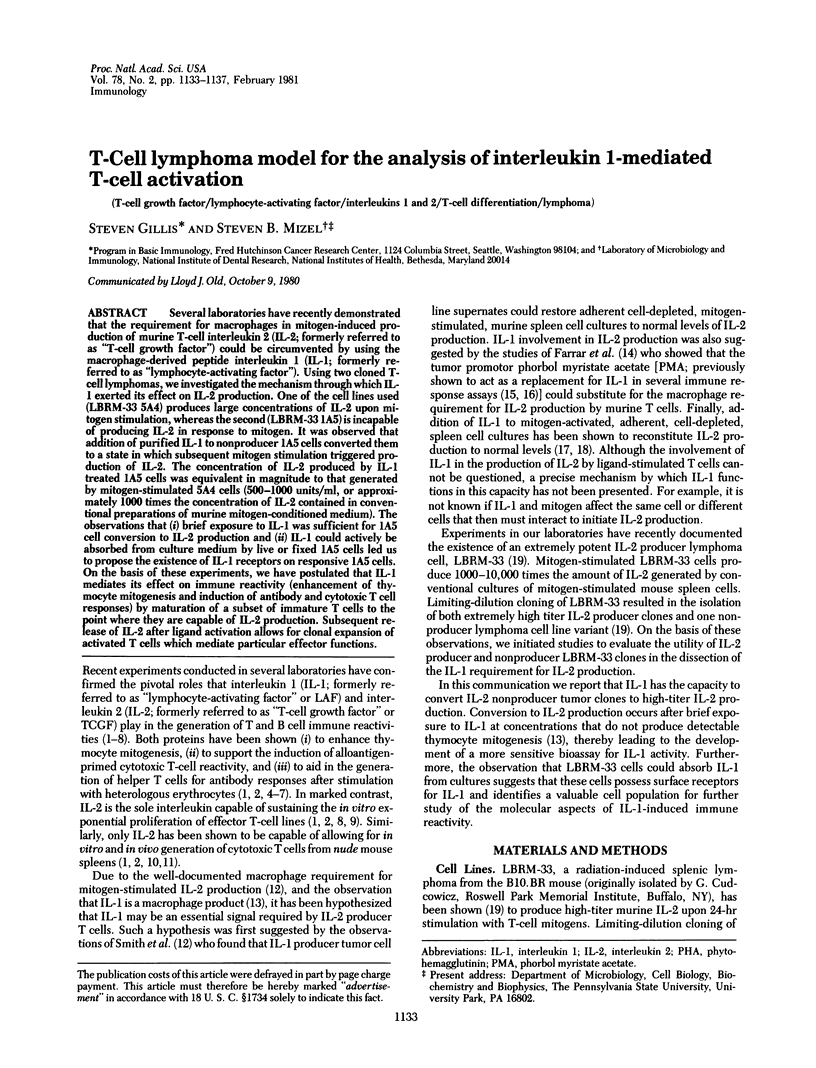Abstract
Several laboratories have recently demonstrated that the requirement for macrophages in mitogen-induced production of murine T-cell interleukin 2 (IL-2; formerly referred to as "T-cell growth factor") could be circumvented by using the macrophage-derived peptide interleukin 1 (IL-1; formerly referred to as "lymphocyte-activating factor"). Using two cloned T-cell lymphomas, we investigated the mechanism through which IL-1 exerted its effect on IL-2 production. One of the cell lines used (LBRM-33 5A4) produces large concentrations of IL-2 upon mitogen stimulation, whereas the second (LBRM-33 1A5) is incapable of producing IL-2 in response to mitogen. It was observed that addition of purified IL-1 to nonproducer 1A5 cells converted them to a state in which subsequent mitogen stimulation triggered production of IL-2. The concentration of IL-2 produced by IL-1 treated 1A5 cells was equivalent in magnitude to that generated by mitogen-stimulated 5A4 cells (500-1000 units/ml, or approximately 1000 times the concentration of IL-2 contained in conventional preparations of murine mitogen-conditioned medium). The observations that (i) brief exposure to IL-1 was sufficient for 1A5 cell conversion to IL-2 production and (ii) IL-1 could actively be absorbed from culture medium by live or fixed 1A5 cells led us to propose the existence of IL-1 receptors on responsive 1A5 cells. On the basis of these experiments, we have postulated that IL-1 mediates its effect on immune reactivity (enhancement of thymocyte mitogenesis and induction of antibody and cytotoxic T cell responses) by maturation of a subset of immature T cells to the point where they are capable of IL-2 production. Subsequent release of IL-2 after ligand activation allows for clonal expansion of activated T cells which mediate particular effector functions.
Full text
PDF




Selected References
These references are in PubMed. This may not be the complete list of references from this article.
- Farrar J. J., Mizel S. B., Fuller-Farrar J., Farrar W. L., Hilfiker M. L. Macrophage-independent activation of helper T cells. I. Production of Interleukin 2. J Immunol. 1980 Aug;125(2):793–798. [PubMed] [Google Scholar]
- Farrar J. J., Simon P. L., Koopman W. J., Fuller-Bonar J. Biochemical relationship of thymocyte mitogenic factor and factors enhancing humoral and cell-mediated immune responses. J Immunol. 1978 Oct;121(4):1353–1360. [PubMed] [Google Scholar]
- Gillis S., Baker P. E., Ruscetti F. W., Smith K. A. Long-term culture of human antigen-specific cytotoxic T-cell lines. J Exp Med. 1978 Oct 1;148(4):1093–1098. doi: 10.1084/jem.148.4.1093. [DOI] [PMC free article] [PubMed] [Google Scholar]
- Gillis S., Ferm M. M., Ou W., Smith K. A. T cell growth factor: parameters of production and a quantitative microassay for activity. J Immunol. 1978 Jun;120(6):2027–2032. [PubMed] [Google Scholar]
- Gillis S., Scheid M., Watson J. Biochemical and biologic characterization of lymphocyte regulatory molecules. III. The isolation and phenotypic characterization of Interleukin-2 producing T cell lymphomas. J Immunol. 1980 Dec;125(6):2570–2578. [PubMed] [Google Scholar]
- Gillis S., Smith K. A. Long term culture of tumour-specific cytotoxic T cells. Nature. 1977 Jul 14;268(5616):154–156. doi: 10.1038/268154a0. [DOI] [PubMed] [Google Scholar]
- Gillis S., Smith K. A., Watson J. Biochemical characterization of lymphocyte regulatory molecules. II. Purification of a class of rat and human lymphokines. J Immunol. 1980 Apr;124(4):1954–1962. [PubMed] [Google Scholar]
- Gillis S., Union N. A., Baker P. E., Smith K. A. The in vitro generation and sustained culture of nude mouse cytolytic T-lymphocytes. J Exp Med. 1979 Jun 1;149(6):1460–1476. doi: 10.1084/jem.149.6.1460. [DOI] [PMC free article] [PubMed] [Google Scholar]
- Koopman W. J., Farrar J. J., Fuller-Bonar J. Evidence for the identification of lymphocyte activating factor as the adherent cell-derived mediator responsible for enhanced antibody synthesis by nude mouse spleen cells. Cell Immunol. 1978 Jan;35(1):92–98. doi: 10.1016/0008-8749(78)90129-6. [DOI] [PubMed] [Google Scholar]
- Larsson E. L., Iscove N. N., Coutinho A. Two distinct factors are required for induction of T-cell growth. Nature. 1980 Feb 14;283(5748):664–666. doi: 10.1038/283664a0. [DOI] [PubMed] [Google Scholar]
- Mastro A. M., Mueller G. C. Synergistic action of phorbol esters in mitogen-activated bovine lymphocytes. Exp Cell Res. 1974 Sep;88(1):40–46. doi: 10.1016/0014-4827(74)90615-6. [DOI] [PubMed] [Google Scholar]
- Mizel S. B. Biochemical and biological characterization of lymphocyte-activating factor (LAF) produced by the murine macrophage cell line, P388D. Ann N Y Acad Sci. 1979;332:539–549. doi: 10.1111/j.1749-6632.1979.tb47148.x. [DOI] [PubMed] [Google Scholar]
- Mizel S. B., Oppenheim J. J., Rosenstreich D. L. Characterization of lymphocyte-activating factor (LAF) produced by the macrophage cell line, P388D1. I. Enhancement of LAF production by activated T lymphocytes. J Immunol. 1978 May;120(5):1497–1503. [PubMed] [Google Scholar]
- Mizel S. B. Studies on the purification and structure-functional relationships of murine lymphocyte activating factor (Interleukin 1). Mol Immunol. 1980 May;17(5):571–577. doi: 10.1016/0161-5890(80)90155-8. [DOI] [PubMed] [Google Scholar]
- Rosenstreich D. L., Mizel S. B. Signal requirements for T lymphocyte activation. I. Replacement of macrophage function with phorbol myristic acetate. J Immunol. 1979 Oct;123(4):1749–1754. [PubMed] [Google Scholar]
- Simon P. L., Farrar J. J., Dind P. D. Biochemical relationship between murine immune interferon and a killer cell helper factor. J Immunol. 1979 Jan;122(1):127–132. [PubMed] [Google Scholar]
- Smith K. A., Gillis S., Baker P. E., McKenzie D., Ruscetti F. W. T-cell growth factor-mediated T-cell proliferation. Ann N Y Acad Sci. 1979;332:423–432. doi: 10.1111/j.1749-6632.1979.tb47136.x. [DOI] [PubMed] [Google Scholar]
- Smith K. A., Lachman L. B., Oppenheim J. J., Favata M. F. The functional relationship of the interleukins. J Exp Med. 1980 Jun 1;151(6):1551–1556. doi: 10.1084/jem.151.6.1551. [DOI] [PMC free article] [PubMed] [Google Scholar]
- Wagner H., Hardt C., Heeg K., Röllinghoff M., Pfizenmaier K. T-cell-derived helper factor allows in vivo induction of cytotoxic T cells in nu/nu mice. Nature. 1980 Mar 20;284(5753):278–278. doi: 10.1038/284278a0. [DOI] [PubMed] [Google Scholar]
- Watson J., Gillis S., Marbrook J., Mochizuki D., Smith K. A. Biochemical and biological characterization of lymphocyte regulatory molecules. I. Purification of a class of murine lymphokines. J Exp Med. 1979 Oct 1;150(4):849–861. doi: 10.1084/jem.150.4.849. [DOI] [PMC free article] [PubMed] [Google Scholar]


